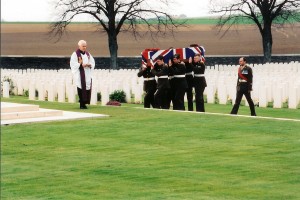One would think that First World War cemeteries were abandoned, long forgotten plots of ground. Not so. Even 94 years after the end of the war, these grassy spaces cut out of the cultivated fields of France see visitors. They come for many reasons; curiosity, historical interest or research, to seek the resting place of an ancestor, to commemorate an anniversary of a battle or great deed of heroism, and some come to bury the dead.
Such was the case on April 21, 2004 as we were touring Somme battlefield sites. Actually I had gotten lost – I was on the wrong road and I was searching for a route back to Albert. We passed Commonwealth War Graves Commission’s Serre Cemetery #2. We recognized it as we had been here several times before. It is one of the largest on the Somme battlefield. Attacks in the area were frequent during the 1916 Battle of the Somme. In spring 1917, the German fell back to the Hindenburg Line leaving the area a great wasteland. A number of new cemeteries were then created to hold the dead from the previous year’s battles. After the war, Serre #2 became an accumulation cemetery for bodies originally buried in area churchyards. It now holds 7,127 Commonwealth burials from the First World War; of these 4,944 remain unidentified.
While this popular location is rarely completely empty, we noticed an unusually large number of vehicles parked along the road in front of it. Small groups of people milled about, including some in military uniform. We realized that some ceremony was about to take place, so we stopped to observe.
It turned out that recent archeological digging near a German pillbox had uncovered the bodies of three soldiers – two German and one British. The bodies had been respectfully returned to their respective governments for disposition. The British had attempted to identify the body by the few remnants of uniform – belt buckle, canteen, or badges that had not completely disappeared after 96 years buried in the sticky clay of Somme. The job proven to be impossible; however, they were able to identify the victim’s unit – 1st Battalion King’s Own Royal Lancaster Regiment, part of the British 4th Division. This regiment had participated in the opening of the great Battle of the Somme – 1 July 1916 advancing upon Redan Ridge and the Heidenkopf defense works. Their casualties had been so great that the regiment was removed from the front and never appeared in that battlefield again. The reconstituted battalion continued to serve on the Western Front until the end of the war.
Today the British private’s body was to be interred among the hundreds of other victims of the Somme Offensive with full military honors. The full-size casket, containing little more than a few bones, was carried to the grave site by today’s members of the descendent of his British Army regiment – the Duke of Lancaster’s Regiment. With local French dignitaries and a handful of British visitors in attendance, the burial service was read by a British minster.
The soldier’s name was not known and he was to lie forever under a grave marker that read ‘An Unknown Soldier of the Great War’. But there were 87 soldiers from that regiment who died on that day and whose bodies had never been recovered. It would be fitting if his name would be remembered one last time. The troopers, each in their turn, called out the names of all 87. Thus, was he remembered.
Two buglers played The Last Post as the wooden casket was lowered into the ground. The ceremony ended with the assembled French and British (and two Americans) singing “God Save the Queen” and “La Marseillaise”.
© 2012 French Battlefields PO Box 4808- Buffalo Grove, Il 60089-4808 USA contact@frenchbattlefields.com or Fax: 1-224-735-3478 http://www.frenchbattlefields.com

